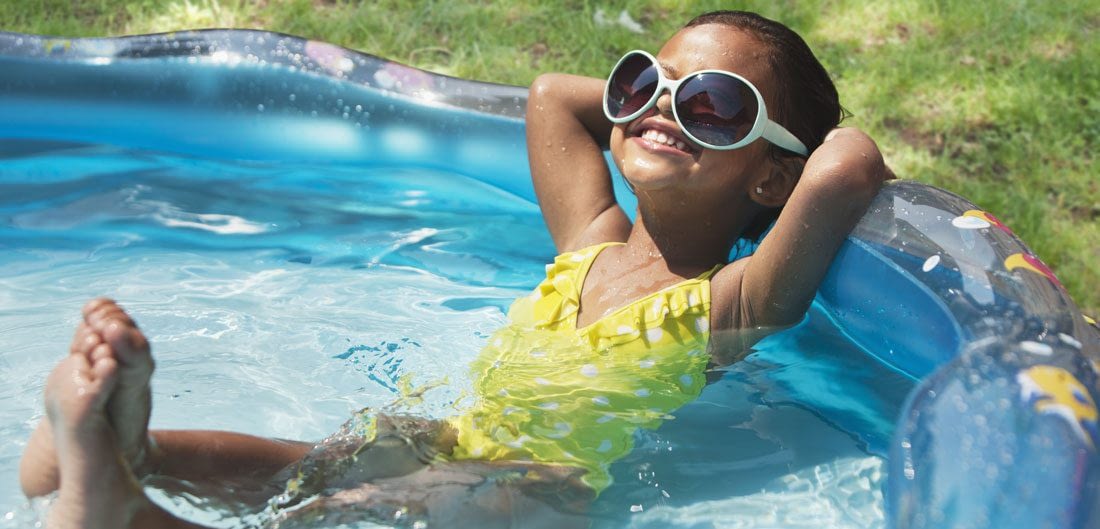
Trampolines
Trampolines can get kids and adults of all ages jumping for joy. But backyard trampoline injuries result in more than 100,000 emergency room visits a year, according to the Consumer Product Safety Commission — making them a leading cause of backyard injuries.
Here are a few tips to improve trampoline safety. Start each year by regularly checking the condition of your trampoline fabric and springs. Check that your trampoline has shock-absorbing pads that fully cover the frame, hooks and springs, and avoid ladders which could give small children unsupervised access. Safety equipment like add-on cage enclosures can keep your little tumblers from bouncing off.
You don’t have to be “the fun police,” but some common-sense safety rules can go a long way to prevent injuries. Consider setting some ground rules like only one jumper at a time, no somersaults or no “double-bouncing.”
Pools
In the hot summer months, there’s nothing like cooling down with a refreshing dip in the pool. But remember that pool safety is an important component of home safety.
Install fencing that’s at least four feet high and features self-locking, self-closing gates. Regularly check and repair the pool’s drain and suction covers to prevent accidental entrapment. Monitor children at all times, and never let anyone swim alone. Have a pool hook, plenty of life vests, a ring buoy with line and a phone close by. Don’t forget to use a pool cover when the fun’s done. One final tip to consider: Remember that it’s a good idea for any pool owner to know the basics of CPR.
Tree houses
The tree house is an icon of backyard fun, offering children hours of entertainment and adventure. But since treehouses are often DIY projects, it’s important to ensure they are a safe place for children to play.
Choose a strong, sturdy tree that’s far away from electrical wires. Keep the house lower than 10 feet off the ground with a solid barrier wall that’s at least 38 inches tall. Don’t hang ropes or chains which can pose strangulation risks, and spread lots of mulch underneath the tree house. Each spring, check for rotting or wear on the tree house and branches supporting it and make any necessary repairs. You should also keep an eye out for poisonous plants like poison ivy, which can climb up trees like a vine.
Fire Pits
For many, having a bonfire means spending time with family, friends and (hopefully) indulging in some S’mores. But whether it’s a fire pit or a gas grill, open flames are always a safety risk. Place fire pits on a non-flammable surface (patio, blocks, concrete) and never put a fire pit directly on grass. Keep the fire small and don’t use gas or lighter fluid to ignite it. Ensure it is completely extinguished before heading in for the night.
One more thing
Anxiety can keep you from enjoying what matters. Rest easy knowing your insurance coverage can keep up with the lifestyle you’ve worked so hard to build.
The truth is, even the most safety-minded among us could someday face a personal injury or liability lawsuit. That’s a scary prospect since payments for hospital bills, rehabilitation, lost wages, pain and suffering, and litigation could potentially wipe out your entire net worth – and even your future earnings.
Fortunately, ERIE offers affordable umbrella policies. An umbrella policy adds an extra $1 to $5 million to both your auto and your homeowners liability limits.
A $1 million umbrella policy typically offers the average person adequate protection for about $150 or $200 more per year.
Contact Us to talk you through your coverage options and help you find the right fit.
On long summer days, kids can occupy themselves for hours in your backyard. (Where do they get all that energy!?)
Whether your yard has a simple swing set or a brand new in-ground pool, it’s a parent’s job to check that everything is in good working condition – and set some ground rules for safety.
Unfortunately, it only takes a small slip-up to spoil the fun. Each year, more than 200,000 kids are treated in hospital ERs for playground-related injuries. Fortunately, you can prevent many of them if you know what to look for around your backyard. Not sure where to start? Follow this list.
The Ultimate Backyard Safety Checklist
Swing sets
If you have young children, there’s a chance swings or an outdoor play set are in your backyard. But did you know that a few small changes can make a big difference in protecting your kids?
To start, install your play equipment on level ground and, if possible, set it in concrete for added stability. Then, add energy-absorbent material like sand, rubber mulch or wood chips underneath the set to help cushion falls. Opt for swing seats made of a soft material like rubber or plastic instead of wood or metal. And periodically check to make sure no screws or bolts are uncapped, rusted or broken.
If your play set is made of wood, inspect the frame for wood rot and other signs of decay.
On hot, sunny days, playground equipment – both metal and plastic! – can heat up to temperatures high enough to cause second-degree burns. Build your playset in the shade if you can. Aim to schedule playtime for cooler hours of the day (like early morning or late evening), and prevent burns by checking the temperature of slides and swings before the kids go out to play.

A better insurance experience starts with ERIE.
Haven’t heard of us? Erie Insurance started with humble beginnings in 1925 with a mission to emphasize customer service above all else. Though we’ve grown to reach the Fortune 500 list, we still haven’t lost the human touch.
Contact May’s Insurance Agency today to experience the ERIE difference for yourself.
